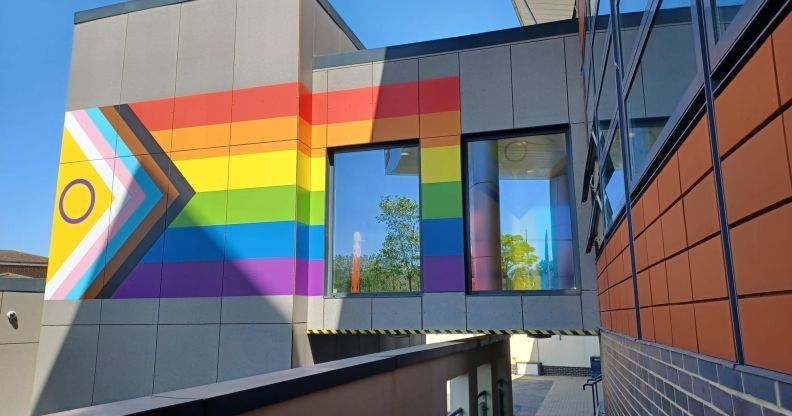NHS hospital celebrates LGBTQ+ rights with jaw-dropping intersex-inclusive Pride flag mural

NHS hospital says LGBTQ+ rights with intersex-inclusive Pride flag mural (Redbox Group)
An NHS hospital in Bromley has been decorated for Pride with an intersex-inclusive mural.
The Princess Royal University Hospital (PRUH) unveiled a mural on Friday (2 June) depicting the intersex-inclusive Pride flag designed by Valentino Vecchietti in 2021.
Vecchietti, who attended the opening of a new bridge and the mural, was happy to see the flag they designed displayed.
“I am delighted to see the PRUH’s commitment to diversity and inclusion,” they said. “The intersex-inclusive Pride flag is a meaningful symbol for our LGBTIQ+ community. It tells us that we are welcome, safe and included.
“Whether we work in the hospital, are here to welcome a new birth, visit a loved one, or if we ourselves are in need of hospital treatment, I hope that the love and humanity in our beautiful Pride flag will provide a gentle and uplifting space for all who need it.”
Professor Clive Kay, the chief executive of King’s College Hospital NHS Foundation Trust, said the health service is committed to equality and diversity as it reaches a major milestone.
“The new bridge is part of our work to make sure patients and visitors have the best experience possible when they visit us. We were also delighted to be able to feature the intersex-inclusive flag as part of its design,” he said.
“In the year that the NHS celebrates its 75th anniversary, the flag’s inclusion in the building’s design is a creative and visible way of communicating our commitment as an organisation to equality, diversity and inclusion, which is a vital part of the care we provide.”
Vecchietti, who is part of the group Intersex Equality Rights UK, redesigned the Pride flag so that it contains a yellow triangle with a purple circle in it, to represent intersex people.
When the flag was created, the group said: “The circle is unbroken and un-ornamented, symbolising wholeness and completeness, and our potentialities. We are still fighting for bodily autonomy and genital integrity, and this symbolises the right to be who and how we want to be.”

